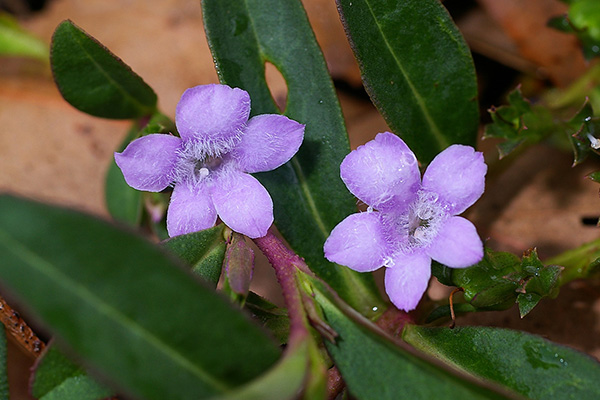General Description:
Eremophila is a large genus of 214 species, all endemic to Australia. They are generally plants of inland and arid areas and are popular with Australian plant enthusiasts.
Eremophila debilis was previously known as Myoporum debile and is still commonly sold and cultivated under that name. It is usually a low, trailing plant with weak, fleshy stems and spreading to around 1.5 to 2 metres in diameter. Some forms may be partially upright in habit to about half a metre. The plant is common in dry, woodland areas and may also be found on grazing land. The leaves are lance-shaped to around 4-5mm long and mid, glossy green in colour. The leaf margins may be entire or slightly toothed.
The small flowers occur in the leaf axils and are usually pale mauve but white and blue forms are also found. The main flowering period is summer but spasmodic flowering may occur at other times. The fleshy fruits that appear in autumn are perhaps the most attractive feature of the plant. They are about 1cm in diameter, green in colour with pink or reddish tonings.
E.debilis has been in cultivation for many years and is a reliable groundcover for many areas. It is suited to a range of soils provided drainage is reasonable, and is best located in a sunny position. Severe frosts may damage the plant but it will often recover quickly once the weather warms up.
Propagation from seed of Eremophila species is unreliable. A number of treatment methods have been tried including sowing the ripe fruits, sowing of aged and washed fruits and splitting the fruits to extract the seeds prior to sowing. The latter involves splitting the fruits in halves and quarters but some seeds are inevitably damaged during the process.
Propagation of E.debilis from cuttings is very easy using hardened, current season’s growth. There may be potential for the use of E.debilis as a root stock for some of the more difficult to grow eremophilas.

Flowers of Eremophila debilis
Photos: Brian Walters

Fruit of Eremophila debilis
Photos: Brian Walters
Images of all Eremophila species, hybrids and cultivars can be seen in the Eremophila Study Group’s Eremophila Image Database
 Australian Native Plants Society (Australia)
Australian Native Plants Society (Australia)













